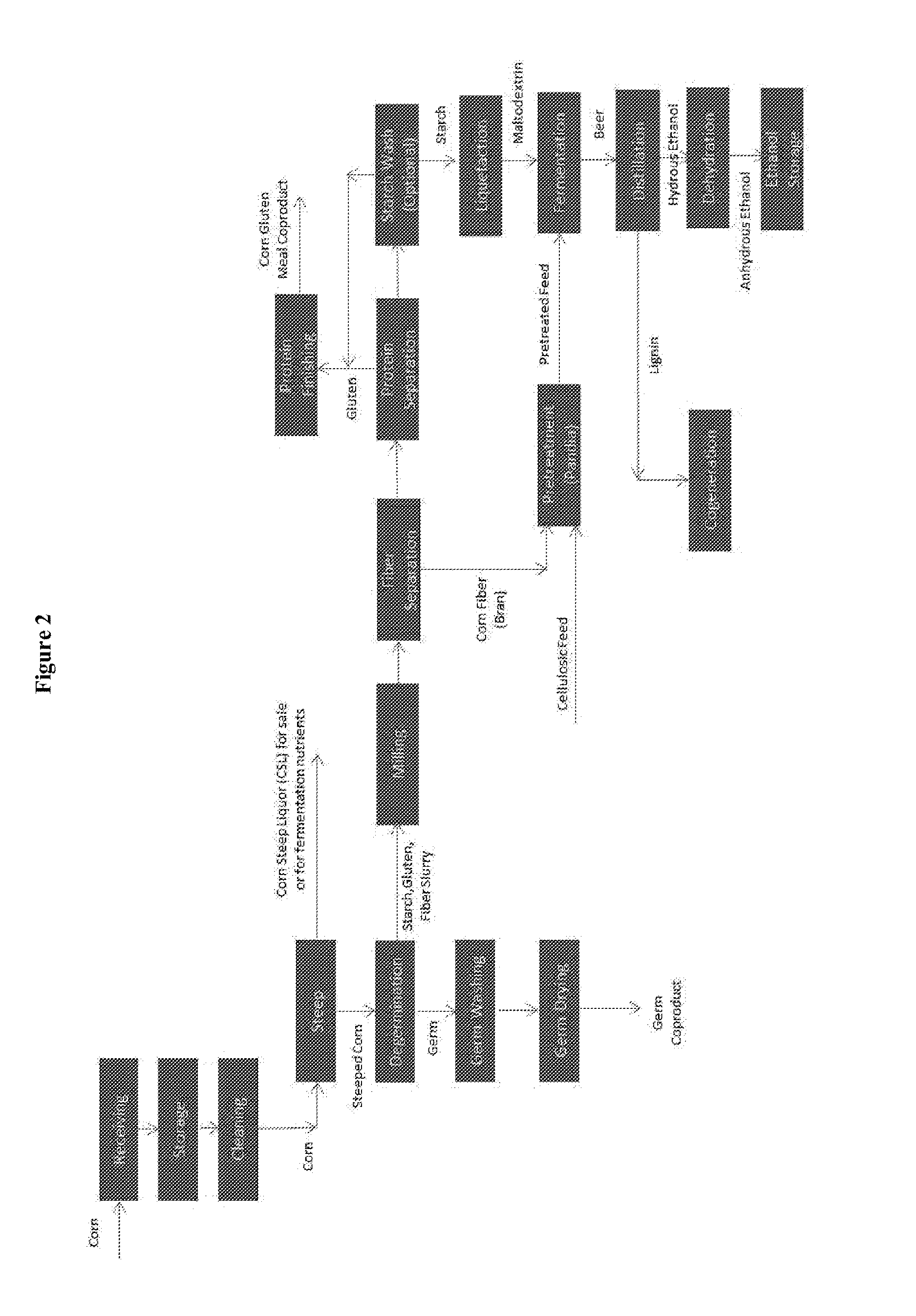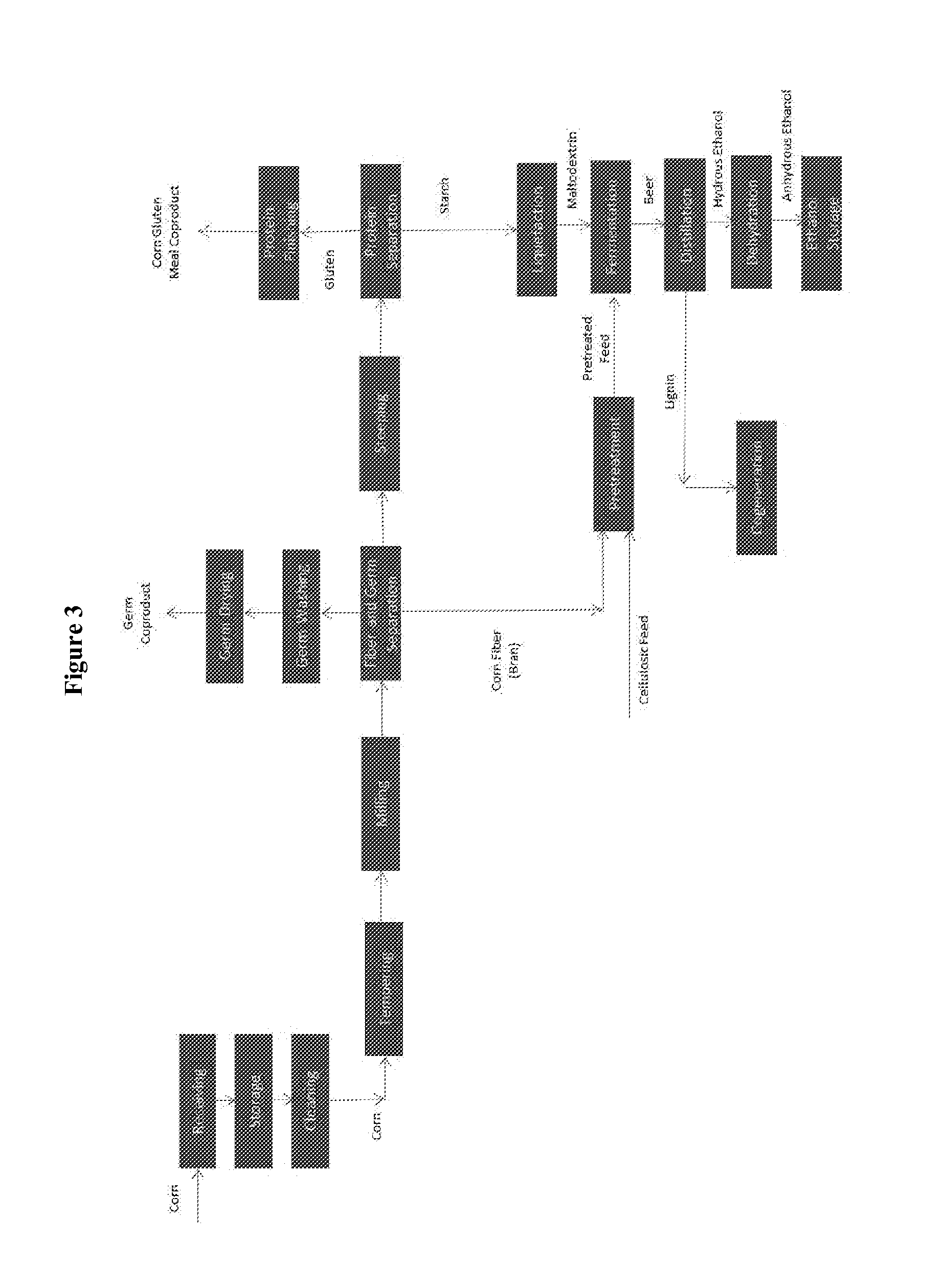Integrated Cellulosic Ethanol Production Process
a cellulosic ethanol and cellulosic ethanol technology, applied in the field of integrated cellulosic ethanol production process, can solve the problems of limited potential integration, unpalatable ddgs for animals, and inability to digest lignin, so as to reduce the capital and operating costs of cellulosic ethanol production and high integration.
- Summary
- Abstract
- Description
- Claims
- Application Information
AI Technical Summary
Benefits of technology
Problems solved by technology
Method used
Image
Examples
integrated embodiments
[0101]In one embodiment, an example of which is shown in FIG. 2, a standard wet fractionation technique can be employed. In this embodiment, corn (after undergoing appropriate cleaning) can be steeped in an aqueous solution optionally including SO2 or an enzyme. Following the steeping process, germ can be separated from fiber and endosperm (starch and protein / gluten). The germ can then be washed and dried for storage and sale.
[0102]The aqueous solution from the steep, or “corn steep liquor,” can be sold or used during the fermentation process, both after removal of SO2, if present. The starch, protein (gluten), and fiber can then be passed to a milling station as a slurry in water. The milling reduces the particle sizes of the various components of the mixture and allows for mechanical separation of the fiber from the starch and protein / gluten. The separated fiber can be stored (not shown in FIG. 2) or processed in a pretreatment reactor.
[0103]Once separated from the fiber, the prot...
example 1
Cofermentation
[0119]Native yeast (strain M2390) which is not capable of consuming xylose, was compared to xylose utilizing strain M4638 (see, e.g., PCT / US2013 / 000090) in a cofermentation reaction. In each cofermentation, 20 g / l xylose was mixed with 28% total solids corn mash sourced from a commercial operation (standard corn mash containing all corn components including nonfermentables) and fermented for 72 hours in a 50 mL batch shake flask fermentation. Spirizyme Excel (Novozymes)—a glucoamylase—was dosed at a loading of 0.6 AGU (amyloglucosidase units) per gram of total solids, and urea was added as a nitrogen source at a loading of 1000 ppm. Yeast strains M2390 and M4638 were each precultured on YPD (10 g / L yeast extract, 20 g / L peptone, and 20 g / L dextrose) media for 24 hours, and inoculated at 0.3 g DCW / L. The fermentation temperature was held at 35° C. for the first 24 hours, and then shifted to 32° C. thereafter.
[0120]As is shown in FIGS. 6 and 7, M4638 showed that it was p...
example 2
CBH2 Enzyme Production
[0121]An experiment to measure the impact of glucose feeding on enzyme expression for certain yeast strains was carried out with CBH2 expressing strain M1873 (See, e.g., PCT / US2011 / 039192). This strain was cultured in a 2 L working volume Sartorius A+ bioreactor with temperature and pH control. Media used in the experiment was a combination of corn steep liquor (CSL) loaded at 12 g / L (wet weight, 50% solids), diammonium phosphate (DAP) loaded at 2.2 g / L on a dry basis, and magnesium sulfate heptahydrate loaded at 2.46 g / L. Media was also supplemented with pressate from pretreated hardwood (PHW) material to simulate the presence of inhibitors. The PHW material, MS801W, was generated using a pilot scale continuous pretreater by applying steam to red maple hardwood chips to achieve a temperature of 195° C. for 10 minutes. The chips had been soaked in maleic acid resulting in 0.5% w / w % maleic acid in the pretreater. The material was steam exploded and washed with ...
PUM
| Property | Measurement | Unit |
|---|---|---|
| temperature | aaaaa | aaaaa |
| concentration | aaaaa | aaaaa |
| concentration | aaaaa | aaaaa |
Abstract
Description
Claims
Application Information
 Login to View More
Login to View More - R&D
- Intellectual Property
- Life Sciences
- Materials
- Tech Scout
- Unparalleled Data Quality
- Higher Quality Content
- 60% Fewer Hallucinations
Browse by: Latest US Patents, China's latest patents, Technical Efficacy Thesaurus, Application Domain, Technology Topic, Popular Technical Reports.
© 2025 PatSnap. All rights reserved.Legal|Privacy policy|Modern Slavery Act Transparency Statement|Sitemap|About US| Contact US: help@patsnap.com



